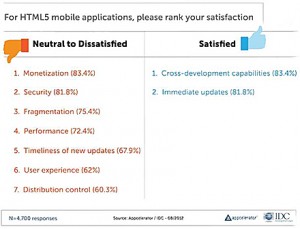As discussed before (“Native apps versus HTML5 apps: Can we mix both for a better solution?”), the development of the HTML 5 standard seemed to reduce the production costs for apps across all platforms, including the browser ecosystem.
One of the fundamental digital rules, “economies of scale” — which was broken by the different store concepts of Apple, Google, et al — is back in the game. Back, too, are standards and cross-platform feature sets with nearly the same performance. This introduces one development for everyone, easy to handle for any further scope. It’s done.
But the latest news out of the development community is sobering: HTML 5 will become a standard HTML, probably in 2014. The compromises this will require are significant.
Software company Appcelerator and IT-research company IDC surveyed 5,526 Appcelerator Titanium users at the end of August. The results pointed out the weaknesses of HTML 5:
- No monetisation model
- Low performance
- Missing updates
- No high-end user experience.

And the last point is key for all media brands: only a high-end, perfect user experience will separate apps from a normal Web site. And will justify a price.
Media brands should be on platforms where the customer demand is:
- iOs
- Android
- Win8.
And for these three platforms, you should develop native apps.
As Facebook did. They have HTML 5 replaced by native code. And the usage exploded.

